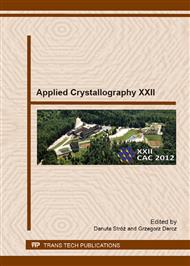p.302
p.306
p.310
p.315
p.319
p.323
p.327
p.331
p.335
Rietveld Analysis of Aurivillius-Type Structure Ceramics Synthesized from Precursors Prepared by Classical and HEBM Methods
Abstract:
The aim of this study was to analyze the influence of the method of preparing the substrates in the form of simple oxides for the structure of the final Bi5Ti3FeO15 ceramics. Milling of the substrates was carried out by two methods: the classical one by hand mixing in a porcelain mortar, and by high-energy. Structure studies were performed by the X-ray diffraction (XRD) method. XRD patterns were analyzed with the Rietveld method using the DBWS 9807a program. It was found out that the slightest deviation of the network parameters from the catalog data occurs for the sample obtained from simple oxides by free sintering (BTFs). Furthermore, it was also determined that the optimal high-energy time of the substrates is 5 hours. When compared to the ICDD catalog data, the resulting ceramics is a single phase one and has the lowest network parameters deviation among all samples which were subject to high-energy.
Info:
Periodical:
Pages:
319-322
Citation:
Online since:
June 2013
Authors:
Price:
Сopyright:
© 2013 Trans Tech Publications Ltd. All Rights Reserved
Share:
Citation:


